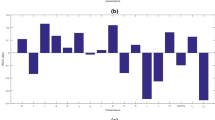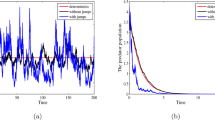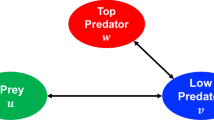Abstract
In this paper, we investigate a predator–prey fish population system and study the harvesting pressure in the presence of stochasticity. We explore the corresponding deterministic model, where the functional response is ratio-dependent and the Allee effect is added in the predator growth function. We find that the Allee effect in predator population increases the number of interior equilibrium points, and a maximum of six interior equilibrium points can be observed. In the deterministic case, we find some interesting dynamics like bi-stability, tri-stability and catastrophic bifurcations. We show that in the presence of noise, an increase in the prey species’ harvesting rate induces critical transitions, one is from higher fish density to lower density and another one is from predator’s stable state to predator’s extinction. We study a few generic early warning indicators namely, Lag-1 autocorrelation (AR(1)), variance, skewness, kurtosis to predict the occurrence of critical transitions. We also calculate conditional heteroskedasticity as an early warning indicator. Furthermore, we study the confidence domain method using the stochastic sensitivity function technique to find a threshold value of noise intensity for a critical transition. We also study the two-stage transition through confidence ellipses and observe that predator population can goes to extinction for any choice of initial conditions with high probability. Overall, our result shows that the stability of the prey–predator fish population depends upon the harvesting rate as well as environmental noises, and we can prevent the extinction of species by controlling them.
Graphical abstract













Similar content being viewed by others
Data availability statement
This manuscript has no associated data. [Author’s comment: This is a theoretical work and all the related data are contained in this article].
References
A.J. Lotka, A Natural Population Norm i and ii (Washington Academy of Sciences, Harvard, 1913)
V. Volterra, Nature 118, 558–560 (1926)
R. Arditi, L.R. Ginzburg, J. Theor. Biol. 139, 311–326 (1989)
R. Arditi, L.R. Ginzburg, H.R. Akcakaya, Am. Nat. 138, 1287–1296 (1991)
W.C. Allee, Animal Aggregations: A Study in General Sociology (University of Chicago Press, Chicago, 1931)
M.H. Wang, M. Kot, Math. Biosci. 171, 83–97 (2001)
F. Courchamp, L. Berec, J. Gascoigne, Allee Effects in Ecology and Conservation (Oxford University Press, Oxford, 2008)
E.D. Conway, J.A. Smoller, SIAM J. Appl. Math. 46, 630–642 (1986)
A. Morozov, S. Petrovskii, B.L. Li, J. Theor. Biol. 238, 18–35 (2006)
J. Wang, J. Shi, J. Wei, J. Math. Biol. 62, 291–331 (2011)
M. Sen, M. Banerjee, A. Morozov, Ecol. Complex. 11, 12–27 (2012)
K. Garain, P.S. Mandal, Int. J. Bifurc. Chaos 30(16), 2050238 (2020)
O.N. Bjornstad, B.T. Grenfell, Science 293, 638 (2001)
T. Coulson, P. Rohani, M. Pascual, Trends Ecol. Evol. 19, 359 (2004)
M. Scheffer, S. Carpenter, J. Foley, C. Folke, B. Walker, Nature 413, 591 (2001)
M. Scheffer, J. Bascompte, W.A. Brock, V. Brovkin, S.R. Carpenter, V. Dakos, H. Held, E.H. Van Nes, M. Rietkerk, G. Sugihara, Nature 461, 53 (2009)
K. Higgins, A. Hastings, J.N. Sarvela, L.W. Bots-ford, Science 276, 1431 (1997)
R.A. Myers, G. Mertz, J.M. Bridson, M.J. Bradford, Can. J. Fish. Aquat. Sci. 55, 2355 (1998)
P. Lundberg, E. Ranta, J. Ripa, V. Kaitala, Trends Ecol. Evol. 15, 460 (2000)
I. Bashkirtseva, L. Ryashko, Phys. A 278, 126–139 (2000)
I. Bashkirtseva, L. Ryashko, Chaos 21, 047514 (2011)
V. Guttal, C. Jayaprakash, Ecol. Lett. 11, 450 (2008)
S. Ghosh, A.K. Pal, I. Bose, Eur. Phys. J. E 36, 123 (2013)
J. Ma et al., Chaos 29, 081102 (2019)
P.M. Vitousek, H.A. Mooney, J. Lubchenco, J.M. Melillo, Science 277, 494 (1997)
J. Lubchenco, Science 279, 491 (1998)
J.M. Fryxell, R. Hilborn, C. Bieg, K. Turgeon, A. Caskenette, K.S. McCann, Proc. Natl. Acad. Sci. USA 114, 12333 (2017)
R. Myers, N. Barrowman, J. Hutchings, A. Rosenberg, Science 269, 1106 (1995)
J.K. Baum, R.A. Myers, D.G. Kehler, B. Worm, S.J. Harley, P.A. Doherty, Science 299, 389 (2003)
D.H. Cushing, D. Cushing, The Provident Sea (Cambridge University Press, Cambridge, 1988)
J.B. Jackson et al., Science 293, 629 (2001)
C.F. Clements, M.A. McCarthy, J.L. Blanchard, Nat. Commun. 10, 1 (2019)
T. Oguz, D. Gilbert, Deep Sea Res. Part I Oceanogr. Res. Papers 54, 220 (2007)
A.C. Kraberg, N. Wasmund, J. Vanaverbeke, D. Schiedek, K.H. Wiltshire, N. Mieszkowska, Marine Pollut. Bull. 62, 7 (2011)
A.J. Pershing, K.E. Mills, N.R. Record, K. Stamieszkin, K.V. Wurtzell, C.J. Byron, D. Fitzpatrick, W.J. Golet, E. Koob, Philos. Trans. R. Soc. B Biol. Sci. 370, 20130265 (2015)
C.F. Clements, J.L. Blanchard, K.L. Nash, M.A. Hindell, A. Ozgul, Nat. Ecol. Evol. 1, 0188 (2017)
V. Dakos et al., PLoS One 7, e41010 (2012)
C. Wissel, Oecologia 65, 101 (1984)
K. Wiesenfeld, B. McNamara, Phys. Rev. A 33, 629 (1986)
S.R. Carpenter, W.A. Brock, J.J. Cole, J.F. Kitchell, M.L. Pace, Ecol. Lett. 11, 128 (2008)
E.H. Van Nes, M. Scheffer, Am. Nat. 169, 738 (2007)
V. Dakos et al., Proc. Natl. Acad. Sci. 105, 14308 (2008)
R. Biggs, S.R. Carpenter, W.A. Brock, Proc. Natl. Acad. Sci. USA 106, 826 (2009)
S. Sarkar, S.K. Sinha, H. Levine, M.K. Jolly, P.S. Dutta, Proc. Natl. Acad. Sci. USA 116, 26343 (2019)
C. Boettiger, A. Hastings, J. R. Soc. Interface 9, 2527 (2012)
P.S. Mandal, L.J.S. Allen, M. Banerjee, Appl. Math. Model. 38, 1583–1596 (2014)
L.J.S. Allen, J.F. Fagan, G. Hognas, H. Fagerholm, J. Differ. Equ. Appl. 11, 273–293 (2005)
R. Arumugam, S. Sarkar, T. Banerjee, S. Sinha, P.S. Dutta, Phys. Rev. E 99, 032216 (2019)
S. Sarkar, A. Narang, S. Sinha, P.S. Dutta, Phys. Rev. E 103, 022401 (2021)
M. Freidlin, A. Wentzell, Random Perturbations of Dynamical Systems (Springer, New York, 1984)
S.I. Skurativskyi, I.A. Skurativska, Commun. Nonlinear Sci. Numer. Simul. 49, 9–16 (2017)
I. Bashkirtseva, L. Ryashko, Int. J. Bifurc. Chaos 249, 1450109 (2014)
P.S. Mandal, Phys. A 496, 40–52 (2018)
D. Wu, H. Wang, S. Yuan, Math. Biosci. Eng. 164, 2141–2153 (2019)
K. Garain, Eur. Phys. J. Spec. Top. 230, 3381–3387 (2021)
S.R. Carpenter et al., Fish Fish. 18, 1150 (2017)
R.M. May, Nature 269, 471–477 (1977)
K. Garain, P.S. Mandal, Ecol. Complex. 47, 100939 (2021)
G. Teschl, Ordinary Differential Equations and Dynamical Systems (American Mathematical Society, Providence, 2012)
L. Perko, Differential Equations and Dynamical Systems, vol. 7 (Springer, New York, 2000)
D.A. Seekell, S.R. Carpenter, M.L. Pace, Am. Nat. 178, 442–451 (2011)
R.F. Engle, J. Econom. 20, 83–104 (1982)
I. Bashkirtseva, L. Ryashko, Math. Comput. Simul. 66, 55 (2004)
I. Bashkirtseva, A.B. Neiman, L. Ryashko, Phys. Rev. E 91, 052920 (2015)
C. Gardiner, Stochastic Methods. A Handbook for the Natural and Social Sciences (Springer, Berlin, 2009)
H. Risken, J.H. Eberly, The Fokker-Planck Equation, Methods of Solution and Applications (Springer, Berlin, 1984)
D.V. Alexandrov, I. Bashkirtseva, M. Crucifix, L. Ryashko, Phys. Rep. 902, 1–60 (2021)
M. Dembo, O. Zeitouni, Large Deviations Techniques and Applications (Jones and Bartlett, Boston, 1995)
G.N. Milshtein, L. Ryashko, J. Appl. Math. Mech. 59, 47–56 (1995)
I. Bashkirtseva, V. Nasyrova, L. Ryashko, Chaos Solitons Fractals 110, 76–81 (2018)
R.A. Fisher, Proc. Camb. Philos. Soc. 26, 528–535 (1930)
Acknowledgements
Koushik Garain’s research is supported by University Grant Commission, India (Student Id: MAY2018-442750) and Partha Sarathi Mandal’s research is supported by MATRICS Project, DST, SERB, India [File No:MTR/2019/000317].
Author information
Authors and Affiliations
Contributions
All authors contributed equally to the paper.
Corresponding author
Appendix 1
Appendix 1
Stochastic sensitivity function (SSF) technique [21, 63, 64]:
The system of stochastic differential equations can be written in the following form:
where x is n-vector, f(x) is a n-vector function, \(\xi (t)\) is a n-dimensional Gaussian white noise satisfying \(\langle \xi (t)\rangle =0,\langle \xi (t)\xi (\tau ) \rangle =\delta (t-\tau )I\), I is an identity matrix , g(x) is \(n\times n\) matrix-valued function of disturbances and noise intensity is \(\sigma \).
We must find a stable interior equilibrium point of the corresponding deterministic system (when \(\sigma =0\)). Let the stable equilibrium point is \(x_*\). When we add noise in the system, ordinary differential equation transformed to a stochastic differential equation or Ito equation. It is supposed that attractor \(x_*\) is exponentially stable. It means that for the small neighbourhood N of the attractor \(x_*\), there exist constants \(M > 0\); \(k > 0\) such that for any solution x(t) of the deterministic system with \(x(0) = x_0 \in N\) the following inequality holds
Here, \(\bigtriangleup (x) = x-x_*\) is a vector of a deviation of the point x from the attractor.
Now, for the corresponding stochastic system, a set of random trajectories is generated. For small noise, the random trajectories are localized in the neighborhood of \(x_*\) owing to the exponential stability of \(x_*\) and form a stationary probabilistic distribution \(\rho (x,\sigma )\), which satisfies the following stationary Fokker–Planck–Kolmogorov equation [65,66,67]:
Even for a two dimensional case, it is very difficult to solve this equation. But we can find solution by approximation. For a small noise, we use the approximation of \(\rho (x,\sigma )\), based on the quasipotential v(x) [50, 68]
where v(x) satisfies the Hamilton–Jacobi equation:
Quadratic approximation of v(x) near the stable equilibrium point is \(v(x) \thickapprox \frac{1}{2}(x-x_*,V(x-x_*)),\) since \(v(x_*)=0\) and \(\frac{\partial v}{\partial x}\big |_{x_*}=0\). V is a positive definite \(n\times n\) matrix. Now the Gaussian approximation of \(\rho (x,\sigma )\) is
with the covariance matrix \(\sigma ^2W\), where \(W=V^{-1}\).
A dispersion (mean-square deviation) of random states near \(x_*\) can be approximated by the following formula [63, 64, 69, 70]:
Here, the matrix W is positive definite and it is the solution of the following matrix equation [69]:
The matrix W is called the stochastic sensitivity function and it characterizes a configurational arrangement of random states of the stochastic system around the deterministic equilibrium \(x_*\)
Here, \(k=-\ln (1-P)\), P is a fiducial probability. Fiducial probability was introduced by R.A. Fisher in 1930 [71], which involves inversion of a probability statement from the distribution function. This means that the random states belong to the interior of this ellipse with probability P.
Rights and permissions
About this article
Cite this article
Mandal, P.S., Garain, K. Two-stage noise-induced critical transitions in a fish population model with Allee effect in predators. Eur. Phys. J. B 95, 63 (2022). https://doi.org/10.1140/epjb/s10051-022-00321-0
Received:
Accepted:
Published:
DOI: https://doi.org/10.1140/epjb/s10051-022-00321-0




